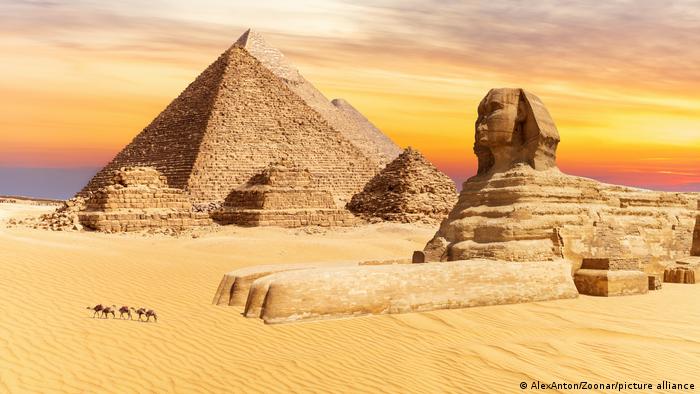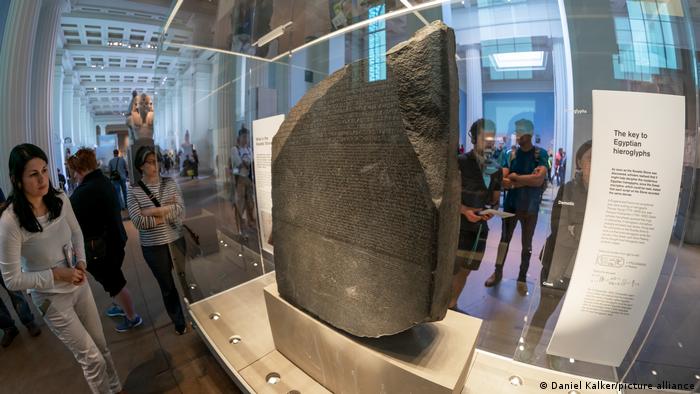Rosetta Stone: Deciphering Mysterious Egyptian Hieroglyphs
The Rosetta Stone: a milestone in deciphering hieroglyphics 200 years ago
On July 19, 1799, French soldiers pulled an inconspicuous stone slab out of the rubble of a demolition wall in Rosetta, a port city on the Nile Delta. Three sections of writing were carved into the surface. None of the men taking part in Napoleon's Egyptian Campaign (1798-1801) preparing to fight the troops of the Ottoman Empire had any idea what treasure they were holding in their hands. But soon the news spread like wildfire.
The stone tablet made of a granite-like igneous rock, just 112 centimeters high and 75.7 centimeters (44 x 30 inches) wide, turned out to be a fragment of a much larger ancient stele.
But what did the inscriptions, letters and symbols mean?
The slab was also damaged: Two thirds of the upper text, illegible hieroglyphics, were missing. In addition, many lines were damaged at the edges. The middle text in Demotic script, an ancient Egyptian form of writing for daily business, was the best preserved. Of the lower, ancient Greek text, a large corner piece was missing.
Egypt is rich with ancient wonders, including the Sphinx and the Pyramids of Giza
A mysterious discovery
But what did the three texts mean? Were they identical messages in different languages and scripts? Lieutenant Pierre-Francois Bouchard, commander of the Napoleonic expeditionary corps, was completely fascinated. The mystery plagued him. He informed French archaeologists who had accompanied the troops. But even they had no explanation and wanted to take the find back to France for further investigation.
However, that attempt failed in 1801 due to the victory of English troops over the French. The defeated were required to hand over all their ancient Egyptian artifacts. And so the Rosetta Stone arrived in London as spoils of war. To this day, it is exhibited in the British Museum.
Electrified by the mysterious find, researchers from all over Europe then began to decipher the writings.
The Frenchman Silvestre de Sacy first compared the demotic with the Greek part of the text. In 1802, the Swede Johan David Akerblad succeeded in reading the demotic names, thus following up on Sacy's work. The British polymath Thomas Young, in turn, tried to solve the scripture puzzle in a mathematical way, but he did not understand the complex grammar of the ancient Egyptian script.
Linguist Champollion figured it out
It was Jean-Francois Champollion (1790-1832), a French linguist, who finally achieved the breakthrough: Unlike Young, he spoke fluent Coptic and knew a great deal about Egypt and its culture. He discovered that the characters of the Demotic script stood for syllables, while the Ptolemaic hieroglyphs in turn reflected sounds of the Coptic language.
"This allowed Champollion to prove that the Coptic language was behind the hieroglyphic script," Hanover-based Egyptologist Christian Loeben told DW. "That's how he deciphered the hieroglyphs."
Absolutely thrilled, Champollion is said to have run into his brother's office and shouted "Je tiens mon affair! ("I've got it!") — only to then faint.
Egyptian hieroglyphics — a pictographic script using human figures, animals and objects — were in use from about 3,200 BC to 400 AD. In time, the written language fell completely out of usage and could no longer be read.
So where exactly did the Rosetta Stone come from? And what were the carved writings all about?
Hieroglyphs reflect sounds from the Coptic language
Scientists assume that the stele was created around 196 BC in the Ptolemaic era (ca. 323 to 30 BC). The rule of the Ptolemaic dynasty had been threatened by power struggles since the death of pharaoh Ptolemy IV. When a revolt broke out in 204 BC, loyalty to the pharaoh was required and an Egyptian synod of priests formulated the so-called "Decree of Memphis" in 196 BC.
It was written in such a way that three groups of the population could read it: For the priests as words of God in hieroglyphics; for the officials in Egyptian in Demotic letter writing; and for the Greek rulers over Egypt in ancient Greek capital letters. Identical stelae were to be erected in every temple in Egypt.
Pride of place for the Rosetta Stone in the British Museum
With the help of the Rosetta Stone, Jean-Francois Champollion created an alphabet of phonetic hieroglyphs. Other scholars were able to use it to translate the inscription completely.
"Thanks to the Rosetta Stone, Champollion was able to decipher the hieroglyphs. This gave the Egyptians their voice again," says Loeben, who heads the Egyptian Department at the Kestner Museum in Hanover. "At the same time, it marked the birth of Egyptology."
Who are the owners?
To this day, the Rosetta Stone is considered one of the most important archaeological finds ever. Its significance is huge — and not only for science. After all, to whom does the artifact that reached England during colonial times belong?
"The stone belongs to humanity, no matter where it is," says German Egyptologist Loeben. "Egyptian objects in museums around the world are Egypt's best ambassadors outside the country." This also benefits tourism, he says, which ultimately brings money to the land of the pharaohs.
Loeben is currently preparing a major exhibition on the Rosetta Stone for the Roemer and Pelizaeus Museum in Hildesheim, Germany. The show "Deciphered" will begin on September 9, 2023.
Starting on October 13, 2022, a major exhibition at the British Museum in London titled "Hieroglyphs: Unlocking Ancient Egypt" will honor the achievements of the researchers' discoveries — exactly 200 years after the deciphering of the hieroglyphs.
This article was originally written in German.
Get the latest reports & analysis with people's perspective on Protests, movements & deep analytical videos, discussions of the current affairs in your Telegram app. Subscribe to NewsClick's Telegram channel & get Real-Time updates on stories, as they get published on our website.
















